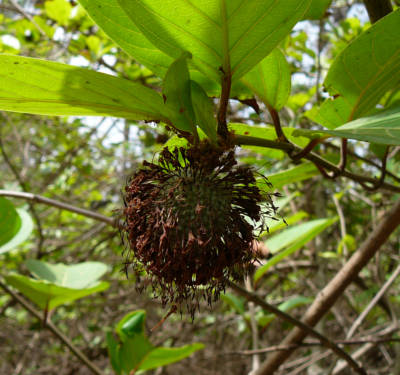Sustainable harvest for medicinal plant
To aid its sustenance, scientists draw model of the root system of one of West Africa’s best medicinal shrubs.
Published online 29 May 2015

The African peach is widely used in sub-Saharan Africa as an affordable painkiller for various ailments.
© Atamari
Ecologists working in West Africa have produced a model that predicts how a significant medicinal plant can be harvested in a sustainable way that minimizes the impact on the environment1.
Sarcocephalus latifolius, the African peach, is a multi-stemmed shrub that synthesizes a painkiller called tramadol in its root bark. Such medicinal plants are used widely throughout sub-Saharan Africa, where they provide an easily accessible source of medication, but many species are being overexploited, and some are now in decline.
Sibiry Albert Kaboré of the Polytechnic University of Bobo-Dioulasso in Burkina Faso and his colleagues examined the root system architecture of S. latifolius to determine the root biomass, and determine which harvesting practices maximize yield while conserving the species.
The shrub or small tree has many medicinal properties, and various parts of it are used widely throughout sub-Saharan Africa. In the southwestern region of Burkina Faso, the roots of the plant are used to treat stomach ache, malaria, and hernias; elsewhere, its reddish-brown fruit is eaten as a cough remedy.
Kaboré and his colleagues randomly selected 40 individual S. latifolius plants from three different sites in the Sudanian zone of southwestern Burkina Faso. Each plant is at the centre of a circular root system, and the researchers dug out one quadrant of each root system and immediately replaced the soil afterwards.
They dug out one root system in its entirety, to make a schematic diagram of its layout, and measured the length and depth of all the excavated roots, the distance between their tips and the trunk, their direction of growth, and their fresh weight.
Their data showed that the plants in this region have an average of eight lateral roots each, and an average length of about 11 m. The root systems examined were mostly distributed between 10 and 50 cm deep, with an average fresh weight of 43 kg.
The ‘semi-destructive’ method of excavating the root systems was used to avoid further damage to the plants, and indeed follow-up observations revealed that very few of the plants sampled had died in the two-year period after the study.
The researchers conclude that people using this plant should harvest the tips of the roots instead of roots near the trunk, in order to keep the plants alive and help preserve the species.
“We think that our model is applicable to trees and shrubs of the savannas and dry forests with a little tap root,” says Kaboré. “We are continuing to study other aspects of the species’ roots, like anatomy and growth.”
Reference
- Kaboré, S. A., Hahn, K., Hien, M. & Nacro, H. B. Does the description of a root system matter for sustainable use and conservation? A case study in Burkina Faso. QScience Connect2015, 3 (2015). | article
DOI: 10.1038/qsh.2015.62

